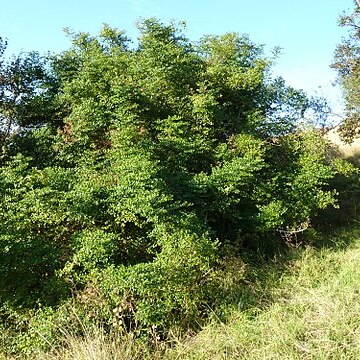An evergreen scrambling shrub. It grows 4 m high and spreads 4 m wide. The branches are slender and flexible and are alternate. They can be trailing and they have a zigzag pattern. There are spines on the stems. These are straight and can be 2.5 cm long. The leaves are green and shiny above but dull green underneath. The flowers are cream or white and star shaped. They are 2 mm across. They are in clusters opposite the spines. The fruit are fleshy and slightly flattened. They are bright orange-red when ripe. They are 13 mm long.
Spiny tree or shrub, 1-6 m high; spines straight, ± 25 mm long; glabrous. Leaves 40-60 x 20-25 mm, opposite, petiolate, ovate, shiny above, margins spinulose-serrulate or Sub-Entire. Flowers in subinterpetiolar, dichotomous cymes. Calyx 5-fid; pubescent. Petals 3x as long as calyx lobes, white, imbricate. Stamens 5, inserted at base of corolla; alternating with petals. Ovary sessile; 1 or 2 ovules; style short. Flowering time Sept.-May. Fruit an ovoid drupe, ± 10 mm long, yellow-orange.
Spiny, scrambling shrub, up to 5 m high. Spines straight, very acute, ± 25 mm long. Branches alternate; young ones zigzagging. Leaves opposite; blade elliptic to ovate, 35-60 x 13-26 mm, apex acute, margins with scattered sharp-tipped teeth. Flowers: small; in axillary, dichotomously branched panicles, ± 7 mm wide; bisexual; disc 0; calyx 5-lobed; petals 5, white; Nov.-Jan. Fruit an ovoid or subglobose drupe, ± 12 mm long, with persistent style, yellowish orange when ripe.
Scrambling shrub or small tree to 5 m, often with single interpetiolar thorns. Leaves opposite, elliptic-ovate, margins revolute and sharply toothed. Flowers few in interpetiolar cymes, white.


